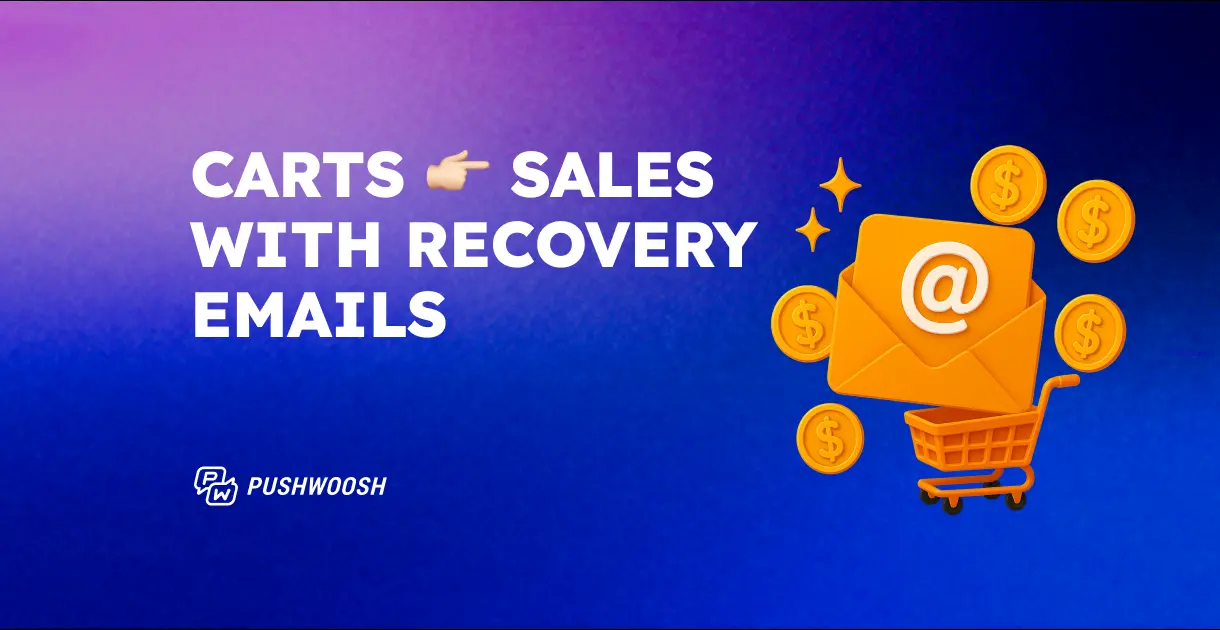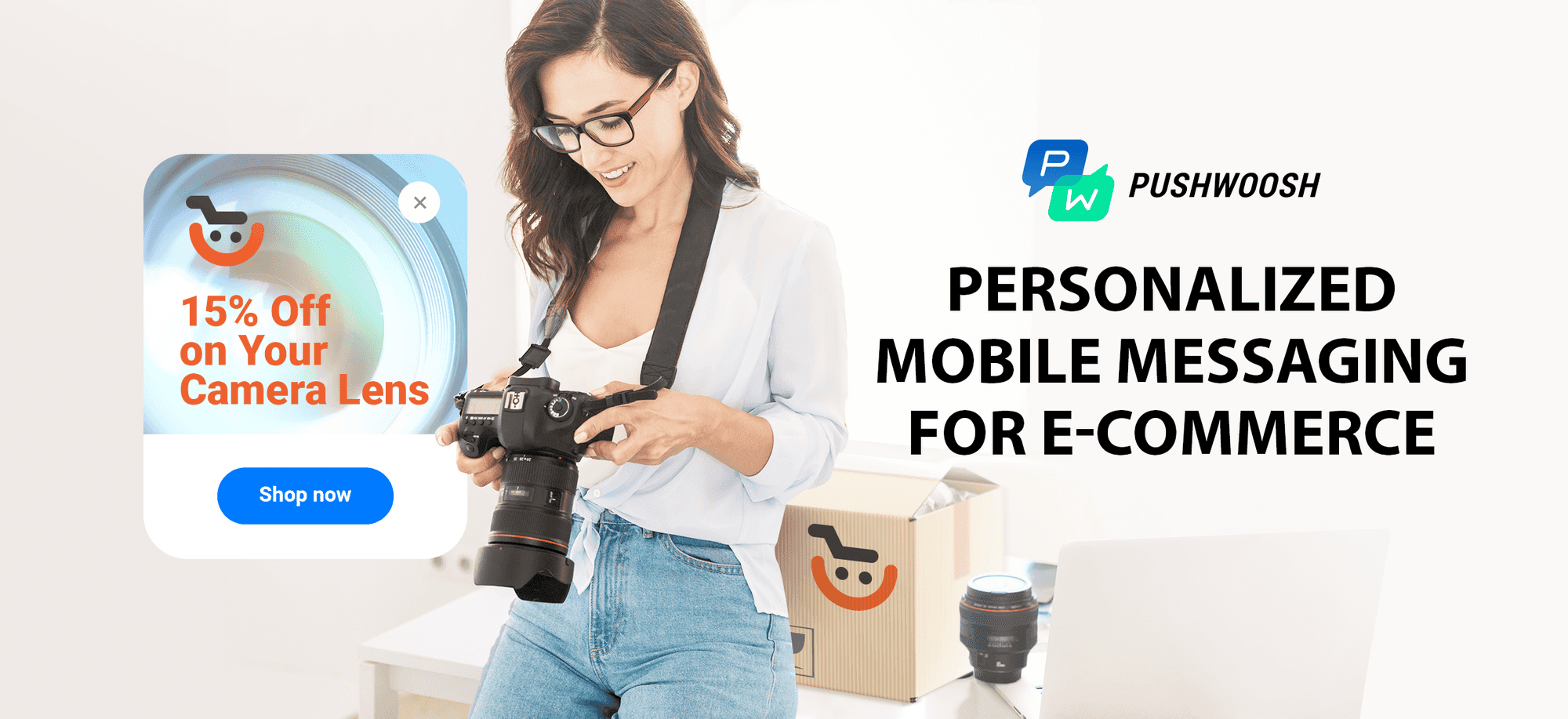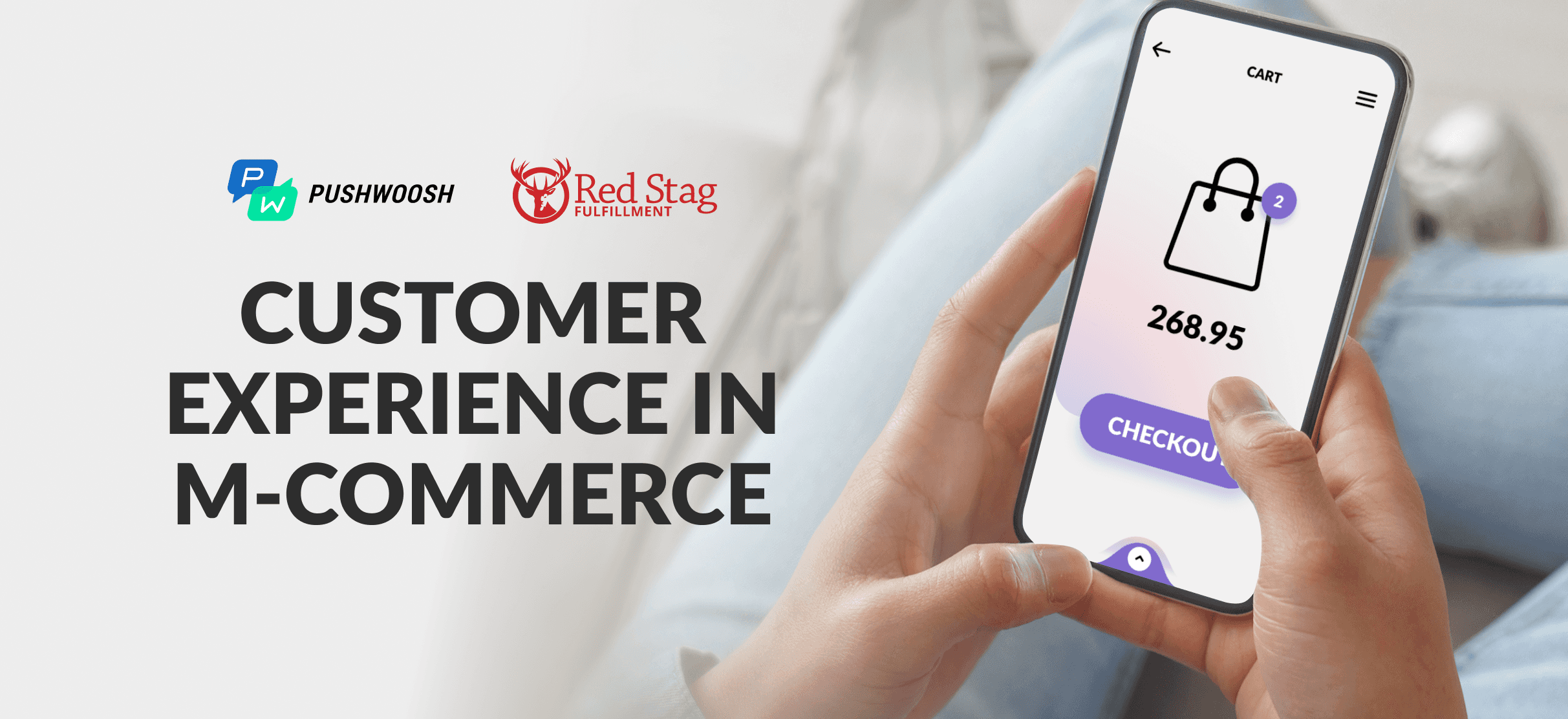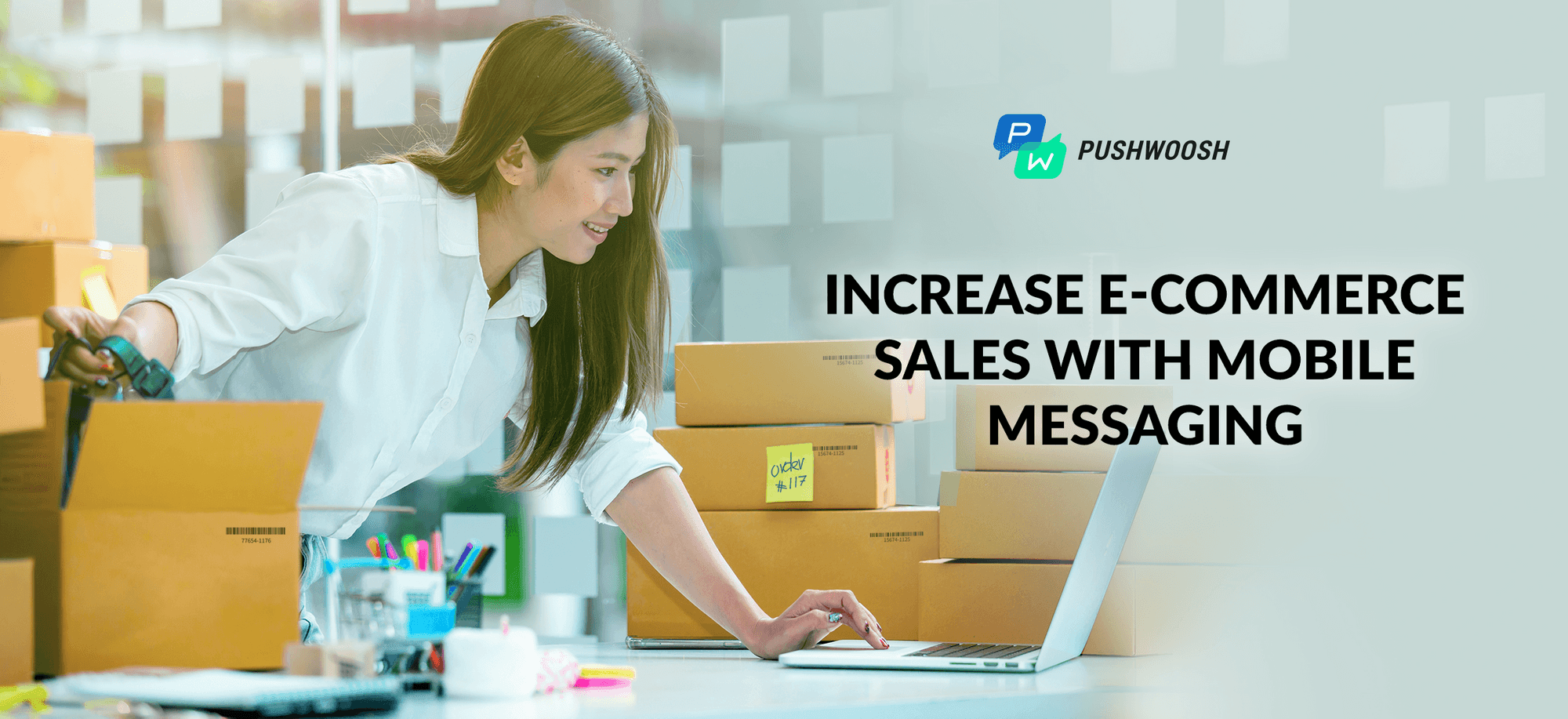E-commerce push notifications: 2025 benchmarks, strategy & examples
Are your push notifications for e-commerce getting ignored? With so many messages hitting users every day, it’s getting harder for e-commerce and retail businesses to break through the noise. But here’s the thing — it’s not about sending more; it’s about sending smarter.
Pushwoosh analyzed 500,000 e-commerce push notifications across industries (from apparel to e-pharmacies), as well as different business sizes and regions. What we found is both surprising and promising: some campaigns achieved 10X higher CTRs than the industry average due to an effective e-commerce and retail push notification strategy.
Here’s what you’ll learn about e-commerce push notifications:
• Simple ways to improve timing, targeting, and message content
• How to use automation to turn shoppers into loyal customers
• What top e-commerce apps do differently (with real results)
Want to stop being ignored and start driving clicks that convert? Let’s dive in.
Know your e-commerce push notitifcation benchmarks, but aim higher
CTR
In our latest study, the average CTR for retail apps sat at 3.05% on iOS and 3.78% on Android devices — both well above the all-industry benchmarks of 1.71% and 2.75%, respectively.
However, there is still room to grow.
Some e-commerce push notitifcations in our analysis performed up to 10 times better, proving that users do engage with them — when the content is timely, relevant, and personalized (we’ll talk about it later in this post).
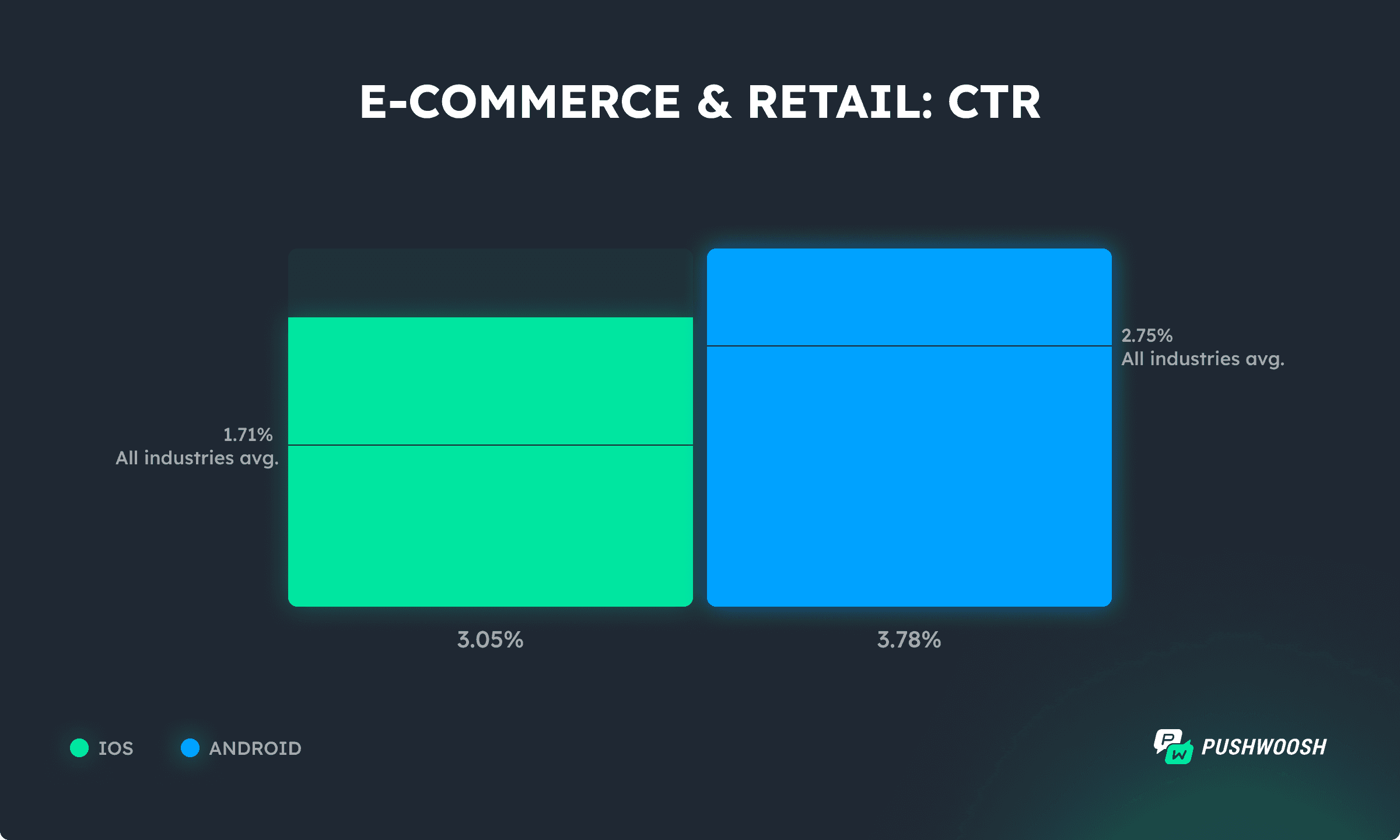
While the average CTR for e-commerce stands at 3.05–3.78%, the best-performing campaigns far exceed this. These messages weren’t louder — they were smarter. They reached users when they were most likely to act, and spoke to interests and behaviors, not just demographics.
Opt-in
Now let’s talk about opt-ins — e-commerce apps continue to show strong rates.
On Android, e-commerce opt-in reaches 75.28%, almost identical to the all-industry average. Even on iOS, where users have to actively grant permission, more than 52% opt in — a number that still reflects a high level of user trust.
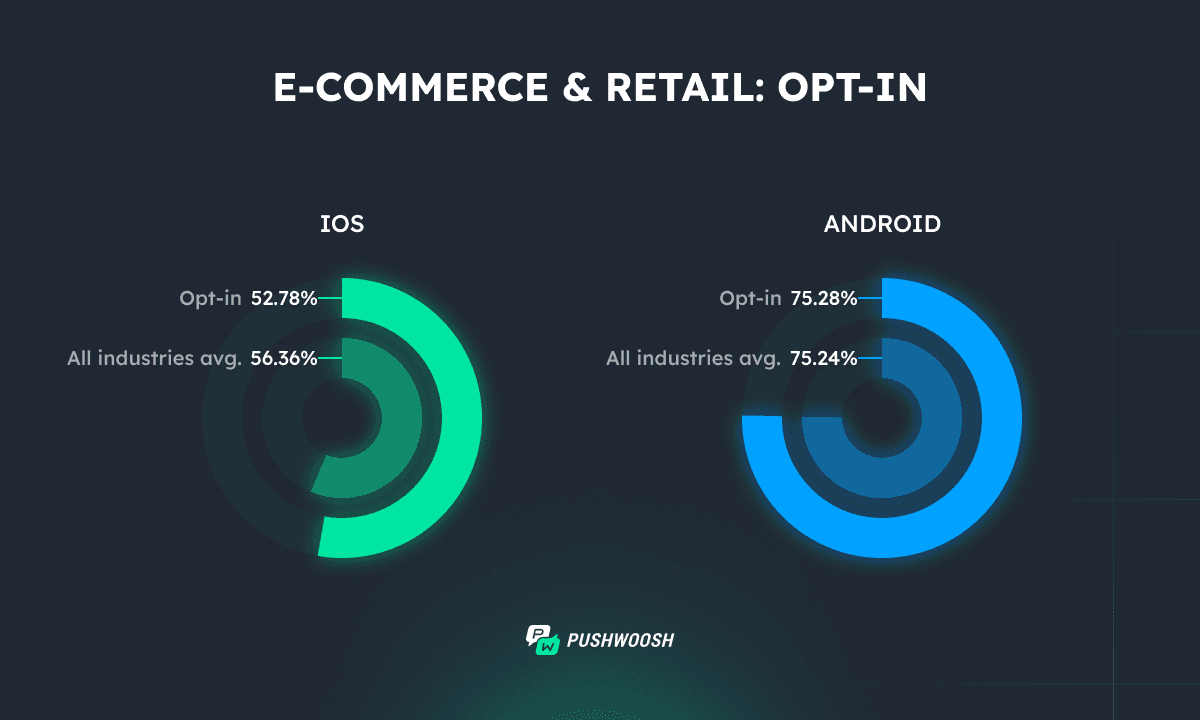
What does this mean?
Shoppers are open to hearing from you — but only if you make it worth their while. Push notifications shouldn’t be reminders to mute your app. They should feel helpful, personal, and well-timed.
So if you see low engagement in your mobile app push notifications, the issue likely isn’t the channel. It’s how you use it.
Rethink frequency: It’s about timing, not quantity
Many assume that daily reminders keep users engaged. But e-commerce customer data shows otherwise. In reality, most users don’t open shopping apps every day — and too many notifications can feel like spam.
The better question to ask is: When should I send push notifications for the best impact?
Let’s look at the numbers:
DAU
The share of daily active users (DAU) in e-commerce is lower than the average across platforms:
• iOS: 3.13% (vs. 3.84% industry avg.)
• Android: 4.29% (vs. 4.96% industry avg.)
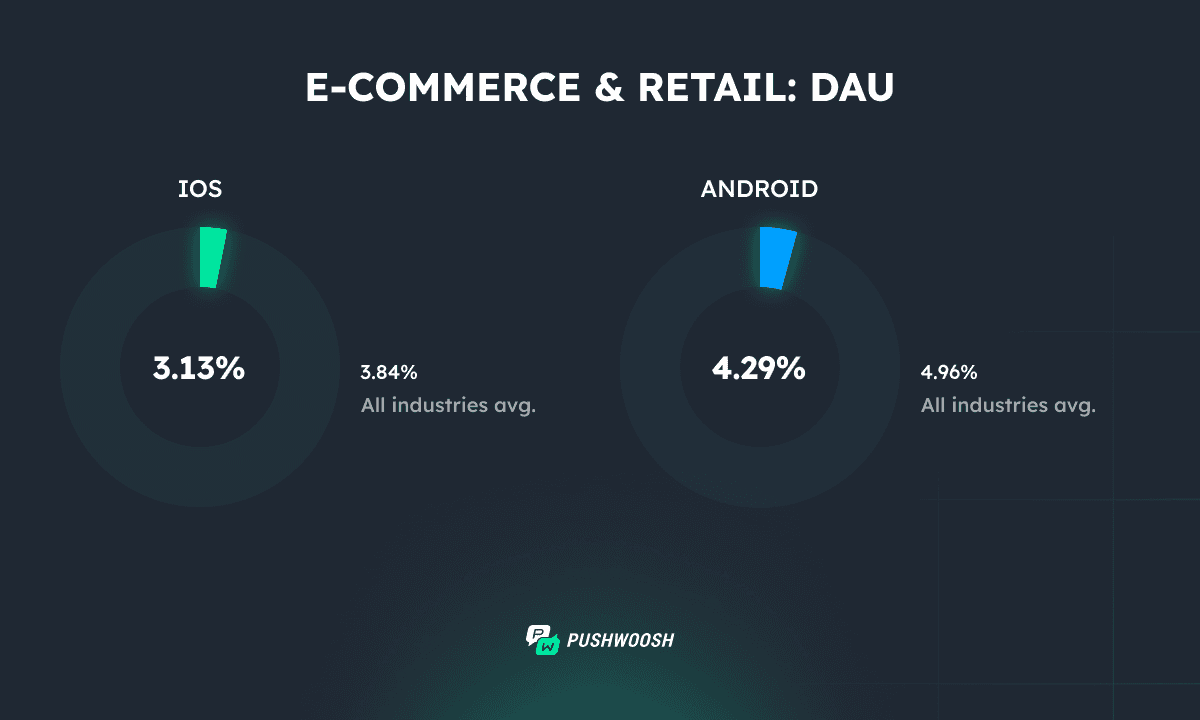
MAU
However, monthly active users (MAU) tell a more optimistic story:
• iOS devices: 25.11% (above industry avg. of 18.99%)
• Android devices: 35.87% (above industry avg. of 34.27%)
• In some cases, up to 65% of users engage monthly

What does this mean for your push notification strategy?
Users don’t want to hear from you daily — they want to hear from you when it makes sense and receive timely messages. This is why MAU-focused strategies work best in e-commerce.
How often should you send push notifications in e-commerce?
1–2 push messages per day is the ‘golden rule’ for e-commerce apps. It’s enough to stay top of mind without overwhelming your users. Sending fewer notifications helps ensure each one has purpose — whether it’s a personalized offer, a cart reminder, or a timely product drop.
Recommended frequency by category:
- Fashion & apparel: 2–4 messages/week (new drops, flash sales)
- Electronics: 1–2/week (price drop alerts, new arrivals)
- Beauty & health: 2–3/week (replenishment reminders, special offers)
- Grocery & delivery: 3–5/week (daily deals, time-sensitive promos)
Promotional pushes: Max 2–3 per week.
Transactional pushes: As needed.
Behavioral triggers (browse & cart abandonment): 1–2 reminders spaced several hours apart.
Supercharge e-commerce push CTRs with smart segmentation
Want to get 10x more clicks from your mobile push notifications? Don’t send the same message to everyone. The most successful e-commerce apps segment their audience — not just by who they are, but by what they do and what they care about.
Our push notification study shows that e-commerce brands targeting users based on both user behavior (like browsing) and interests (like favorite products or categories) saw the biggest gains. CTRs of these contextually relevant messages reached up to 10.36%, compared to under 1% for basic demographic targeting.

RFM segmentation: Don’t ignore your most valuable users
Beyond behavioral triggers, your loyal customers deserve extra attention. With RFM segmentation, you can group users based on how recently they purchased, how often they buy, and how much they spend in your retail store and send notifications accordingly.
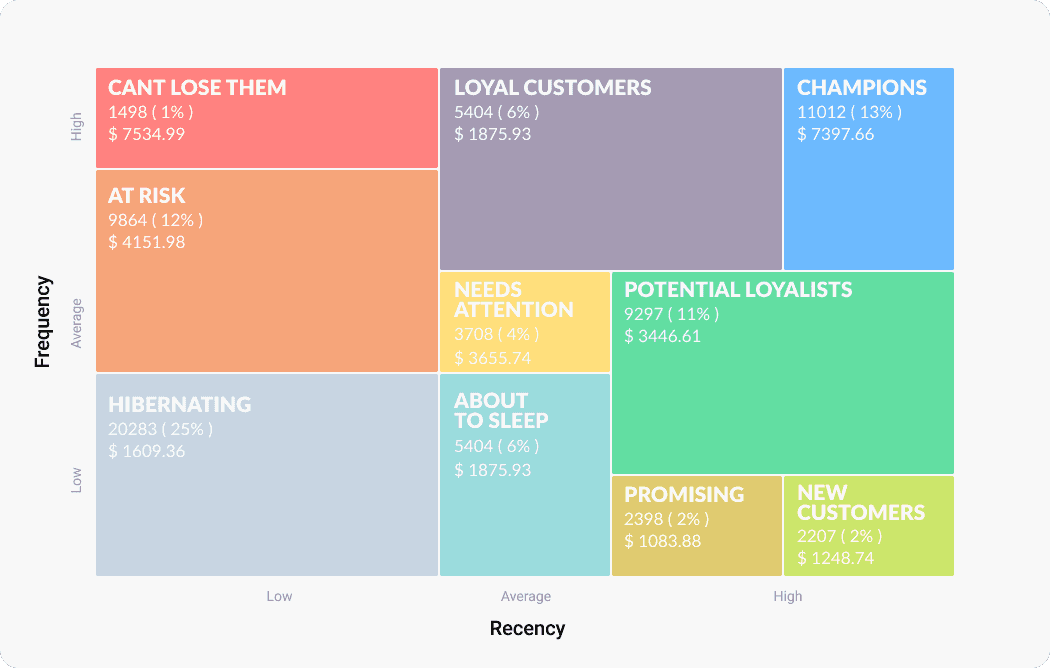
This allows you to:
• Offer exclusive rewards to frequent buyers
• Re-engage at-risk users with time-sensitive promos • Nurture loyalty by recognizing top-tier customers
Case: A beauty brand used RFM segments to send holiday deals to their VIPs (“Friends”) and achieved record-breaking CTRs — all with a simple, personalized message.

Real-world e-commerce triggers to use today
Smart segmentation also means knowing where your customer is in their journey. Here are a few high-performing triggers, reused from our past success stories:
• Abandoned cart: Remind users what they left behind (and offer an incentive)
• Wishlist items back in stock: Tap into saved interests for quick conversions
• Previously viewed product drops: Reconnect users with something they already considered
Learn more about how to build these segments in Pushwoosh’s Segmentation page
Personalization: Even small tweaks deliver big results
You don’t always need complex segmentation or dynamic templates to create personalized push — even a single word can double your click-through rate.
Take this real example
A Pushwoosh client tested two identical push notifications:
• One generic
• One personalized using the user’s first name
The personalized version achieved 2x higher CTR — from 2.68% to 5.22%.

What else can boost engagement?
Emojis
Emojis can add personality to your push notifications, but placement matters.
Our recent study on emojis found that e-commerce and retail apps see the highest CTRs (10.97%) when emojis are used in the message copy. In contrast, placing them in the title leads to significantly lower performance (0.58%). So if you use emojis, keep them in the body, not the headline.

Dynamic content
Adding product names, prices, or categories based on user behavior increases relevance, especially in abandoned cart or back-in-stock notifications.

Visual elements
Rich media like product images, GIFs, or banners can help your notification stand out — just make sure they don’t slow delivery or clutter the message.
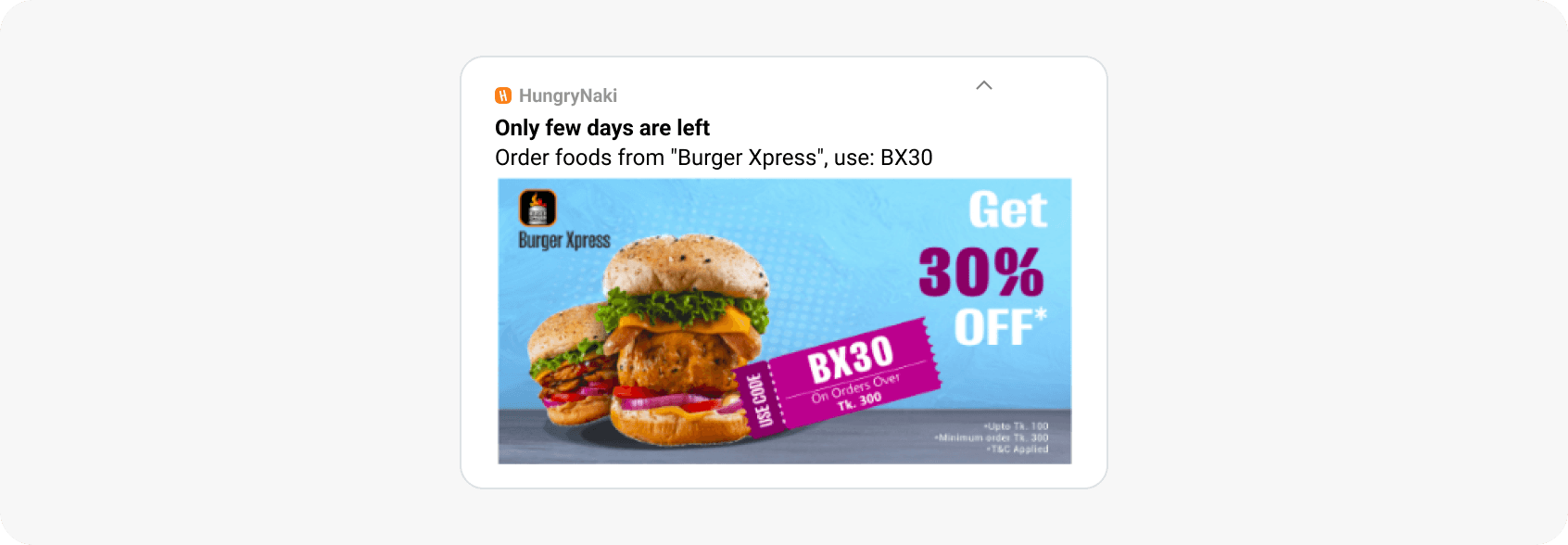
The takeaway: Even minor tweaks in personalized messages — like using a customer’s name or a well-placed emoji — can dramatically boost engagement when done thoughtfully.
Don’t ignore transactional & back-in-stock messages
Not all push notifications need to sell. Some of the highest CTRs come from mobile push messages that simply serve a clear user intent.
Shipping updates, payment confirmations, and order status notifications
Transactional messages are timely, helpful, and high-trust by nature. They consistently outperform promotional campaigns — because users are expecting them.
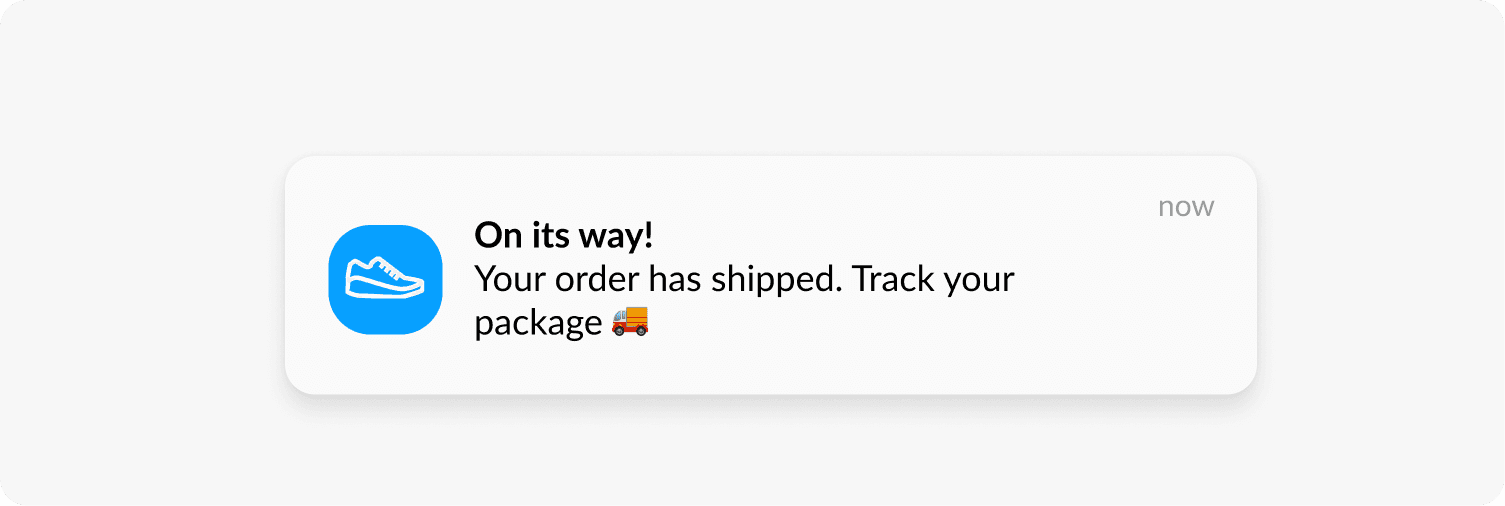
Back-in-stock alerts
They tap into existing demand — users have already shown interest, so the conversion path is shorter. All you have to do is notify them at the right moment.


Location-based promos
“You’re near our store — grab this deal” and post-purchase review requests also work well. They provide utility while encouraging action, creating a positive loop between the brand and the user.

Broadcast messaging: Strategic timing wins
Broadcast mobile push notifications still play an important role — especially for major announcements, sales campaigns, or seasonal drops. But if you’re sending them without strategy, you’re likely wasting attention.
Use broadcast wisely for big promos
Whether it’s Black Friday, a holiday guide, or a mid-season drop, broadcast pushes work best when users are already in shopping mode. Align your messages with known shopping events to boost relevance and maximize impact.

Timing still matters — even for wide campaigns
We’ve already talked about how Monday tends to deliver the highest push CTRs, while Thursday lags behind. That timing insight applies across the board — whether you’re sending a broadcast campaign or a behavior-triggered flow, sending at the right moment can make all the difference.
Send notifications when users are most open to hearing from you. Avoid low-engagement windows and aim to ride natural shopping momentum.
You can still personalize a broadcast
Even if a campaign is targeting a broad audience, it doesn’t have to feel generic.
Tip: You can schedule a broadcast once, but deliver it at the best time for each individual user, based on their engagement patterns and time zone.
E-commerce push notification examples
To make the most of your push notification strategy, you need ready-to-use examples that convert. Below are proven e-commerce push notifications for different stages of the customer journey.
Abandoned cart notifications

Promotional notifications
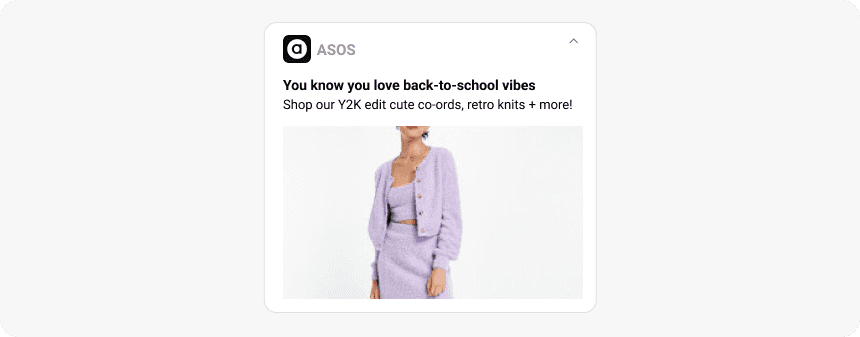
Seasonal offers

Price drop & restock notifications
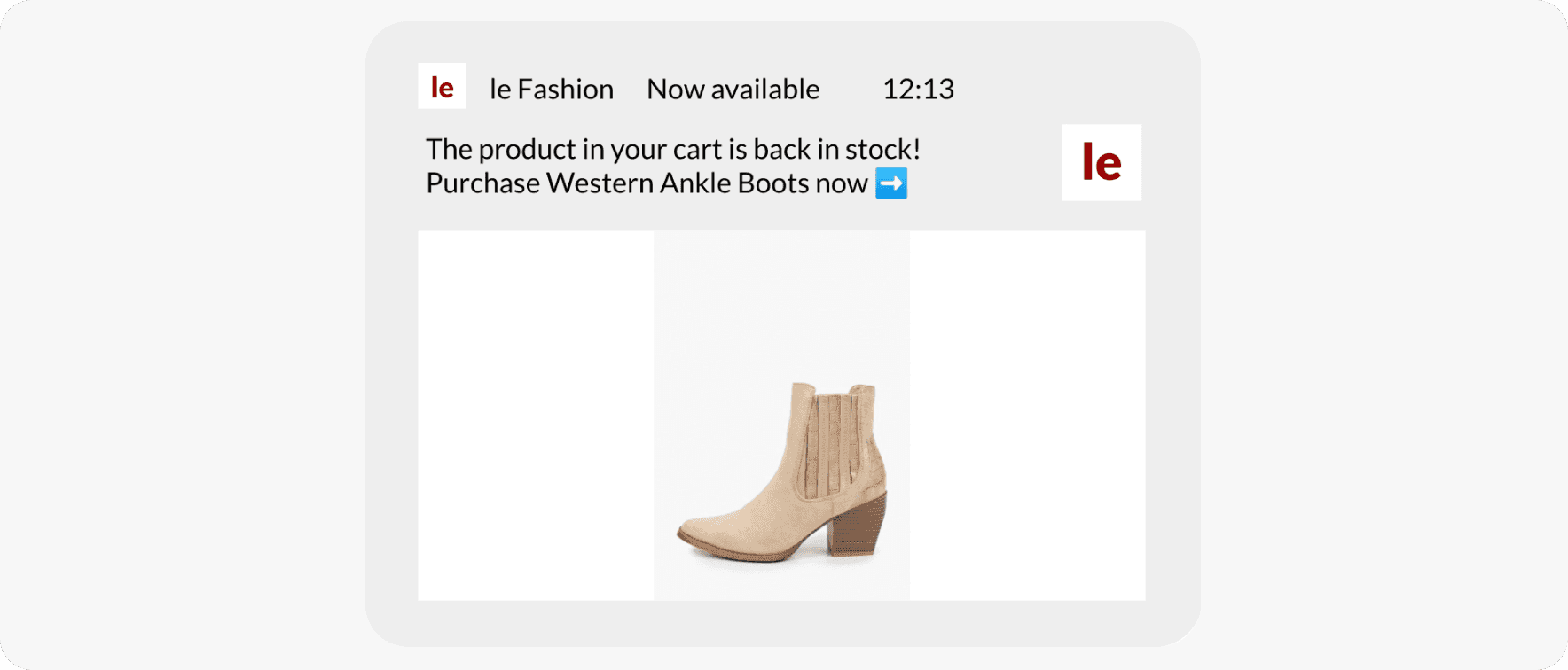
Order & transactional notifications

Geo-based notifications

Web push for e-commerce
Don’t limit your push notification strategy to apps — web push notifications in e-commerce can reach customers even when they’re not browsing your site or app.
Why web push works for e-commerce:
- Instant reach: Send time-sensitive deals and price drop alerts right to the user’s desktop or mobile browser.
- Cart and browse recovery: Web push for e-commerce is perfect for guest users who haven’t installed your app. You can still trigger abandoned cart push notifications or product reminders.
- Opt-in flexibility: Prompt users with a soft pre-permission screen before the browser prompt to increase your opt-in rate.
How top e-commerce brands scale their push notitifcation strategies
All of the best practices in this guide — segmentation, automation, personalization, perfect timing — are powerful tools in the marketing strategy on their own. But when used together in a system, they become a competitive advantage.
That’s where Pushwoosh comes in.
Our customer engagement solution for e-commerce gives marketers the tools not only to create push notifications, but also:
• Build smart audience segments based on behavior and preferences — no manual work or guessing
• Run automated journeys that welcome new users, recover abandoned carts, or re-engage inactive ones — at just the right time
• Use RFM segmentation to treat high-value users differently and reward loyalty
• Incorporate rich media into notifications with product photos, banners, and GIFs
• Send messages across multiple channels — push, email, in-app, SMS, WhatsApp — to reinforce your message and optimize your ROI, especially when you’re reaching tens or hundreds of thousands of users
• Continuously improve with A/B/n testing — what works, scales
You don’t have to build this infrastructure yourself. It’s already here — and you can start using it for free.
Or get in touch with our team to discover more:


